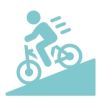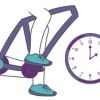Main menu
New Riders Guide
This guide outlines the steps to get a New Rider balancing, pedaling, and steering in 7 steps. Remember: Only move on to the next step when you and the learner feel ready!
Step 1: Teaching Mindset

 Your role as a guide
Your role as a guide 
- Share knowledge
- Instill confidence
- Remain patient
 Action Plan
Action Plan
- Introduce yourself. Let the rider know about a time you learned something new!
- Ask the learner what they hope to achieve and what they are nervous about.
- Set realistic expectations. The learner may not learn to ride by the end of one session but they will make progress.
Step 2: Location
Try to meet as many conditions as possible, but it is fine if you can’t meet them all. Use what you have, but always ensure safety.
Ideal Location 

- Calm
- Minimal traffic
- Spacious
- On a smooth, paved surface
- On a gentle slope
Step 3: Equipment
Action Plan 
- Help the learner get a bike and a helmet in the appropriate size.
- Adjust the saddle so the learner can put their feet flat on the ground when seated.
- Guide the learner through 2V2 helmet and ABC bicycle quick checks. Watch our videos on 2V2 and ABC Quick Check if you're not sure how.
- Optional: Use a balance bike or have a mechanic remove the pedals.
Step 4: Control
 1. Have the learner grasp the handlebars and lean the bike side to side, walk with it, and turn it around.
1. Have the learner grasp the handlebars and lean the bike side to side, walk with it, and turn it around.
Game: Walk beside the bike, fingers on brake levers. Squeeze the brakes to slow down. How far do you squeeze to come to a full stop?
2. Have the learners mount and dismount several times while pressing the brakes.
Keeping fingers on the brakes trains your brain that the hands stop the bike, not the feet. Squeezing the brakes helps to avoid slamming.
Step 5: Balancing
 1. Have learners gently release the brakes, and push themselves along with both feet at the same time (like a frog-hop), keeping their weight on the saddle.
1. Have learners gently release the brakes, and push themselves along with both feet at the same time (like a frog-hop), keeping their weight on the saddle.
Challenge them to keep their feet up between hops for as long as they can.
 2. Invite learners to use their brakes when:
2. Invite learners to use their brakes when:
- Mounting and dismounting.
- Gaining speed.
- Feeling unsafe.
Rolling down a gentle slope here will make balancing easier.
Step 6: Pedaling
 Learners are ready to start pedaling when they can coast for 10 seconds or more a couple of times. We have three different exercises they can try:
Learners are ready to start pedaling when they can coast for 10 seconds or more a couple of times. We have three different exercises they can try:
- From a standstill, move one pedal to the 2 o’clock power position. Push off firmly to get momentum while lifting the other foot off the ground to find the second pedal.
- Use the bike like a scooter. With one foot on a pedal in the down position, the other pushes off the ground until it can find the second pedal.
- Start moving by hopping. Push both off the ground at the same time to find the pedals.

Resist holding the learner's bike. They need to learn by feeling the balance.
Step 7: Maneuvering
Practice:
- Wide turns
- Riding on narrower paths
- Riding up and down gentle slopes
- Riding in a single-file
You can download a print version of this guide here, and check out the video below!

